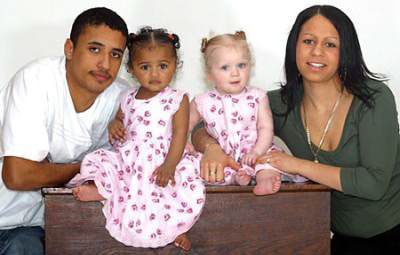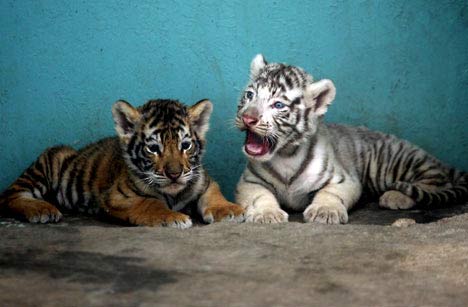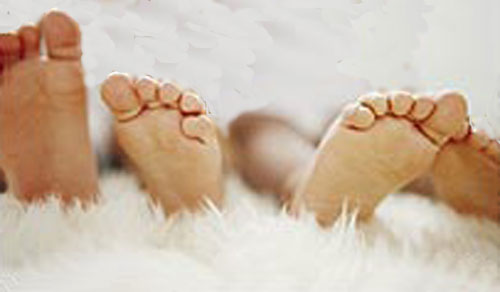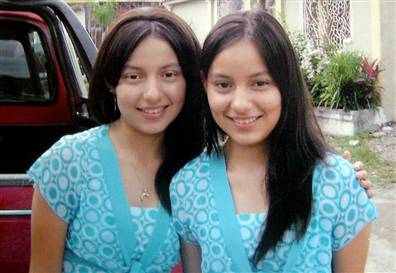It Takes Two
Twins in Black and WhiteYou share your birthday with at least nine million other people in the world. - dailyspark.com
Source: The Evening Post Monday 26 June 2000
Twins Have Different FathersA Croatian woman who slept with two men at the same time has given birth to twins with two different fathers. The 23-year-old student, who has been named only as M B, gave birth to non-identical twins in Zagreb seven months ago. However, she has revealed that DNA testing has shown the children have different fathers. She told daily Jutarnji List, "I was shocked at getting pregnant and even more surprised when doctors told me that my two sons had different fathers." Doctors have said twins being born to different fathers is extremely rare. Source: ananova.com Monday 13 January 2003
Twins Have Different DadsA Chinese man is suing for divorce after discovering that he is the father of only one of his twins. Liu Yuan of Nanjing city says he noticed the difference between the babies the day they were born, reports Longhu Network. "The baby that came out first was much bigger than the second, who was very weak and sickly," he said. Liu says he started to be suspicious when the smaller baby turned out to have a different blood type, along with the fact that it doesn't look like him. Liu had his own and the two babies' DNA tested - and discovered that he was the biological father of only the bigger twin. "My wife admitted that she'd had sex with her former boyfriend after we got married," he said. Doctors explain that it's quite rare, but possible, since a man's sperm can survive for 72 hours in a woman's body. Source: ananova.com 27 November 2007
When a woman has twins with two different fathers, it is called heteropaternal superfecundation - and may not be quite as rare as once thought. Three HS cases were found in a parentage test database of 39,000 records. The frequency of HS among dizygotic twins whose parents were involved in paternity suits is 2.4%.
Black and White Twins
Kylie with partner Remi and daughters Remee and Kian by Lucy Laing When Kylie Hodgson gave birth to twin daughters by caesarean section, she was just relieved that they had arrived safely. It was only when the midwife handed them over for her to hold that she noticed the difference between them. Remee, who weighed 5lb 15oz, was blonde and fair skinned. Her sister Kian, born a minute later weighing 6lb, was black. "It was a shock when I realised that my twins were two different colours," said Kylie, 19. "But it doesn't matter to us - they are just our two gorgeous little girls." The amazing conception happened after two eggs were fertilised at the same time in the womb. Both Kylie and her partner Remi Horder, 17, are of mixed race. Their mothers are both white and their fathers are black. According to the Multiple Births Foundation, baby Kian must have inherited the black genes from both sides of the family, whilst Remee inherited the white ones. Kylie, from Nottingham, discovered she was pregnant in the summer of 2004 and a scan at the Queen's Medical Centre revealed that twins were on the way. "It was a shock at first to discover I was expecting as we hadn't been trying for a family," she said. "I had my 14-week scan and the sonographer ran the scanner over my stomach and announced that I was carrying twins. We couldn't believe it. Neither of us could take our eyes off the scanner - you could just see two of everything, even the outline of their little noses. We were both overwhelmed." The twins were born by caesarean in April last year because one of the girls was lying in an awkward position in the womb. "I didn't see them at first," added their mother. "They were both whisked away to be checked over and then the midwife came back and placed them both in my arms. I noticed that both of them had beautiful blue eyes, but whilst Remee was blonde, Kian's hair was black and she had darker skin. It seemed strange, but I was feeling so ill that I didn't really take it in at that stage." The next day she mentioned the colour difference to her mother, who told her that Remee's skin would darken as she grew older. But as the weeks passed, Remee became lighter still while Kian went darker. And while Remee's eyes stayed blue, Kian's turned brown. "There are some similarities between them," said their mother. "They both love apples and grapes, and their favourite television programme is Teletubbies. If they haven't seen each other for a few hours, they are so pleased to see each other and will hold out their arms, wanting to hug each other. And their smiles just light up their faces. I'll explain it all to them when they get older about why they look so different." The odds against of a mixed race couple having twins of dramatically different colour are a million to one. Skin colour is believed to be determined by up to 7 different genes working together. If a woman is of mixed race, her eggs will usually contain a mixture of genes coding for both black and white skin. Similarly, a man of mixed race will have a variety of different genes in his sperm. When these eggs and sperm come together, they will create a baby of mixed race. But, very occasionally, the egg or sperm might contain genes coding for one skin colour. If both the egg and sperm contain all white genes, the baby will be white. And if both contain just the versions necessary for black skin, the baby will be black. For a mixed-race couple, the odds of either of these scenarios is around 100 to one. But both scenarios can occur at the same time if the woman conceives non-identical twins, another 100 to one chance. This involves two eggs being fertilised by two sperm at the same time, which also has odds of around 100 to one. If a sperm containing all-white genes fuses with a similar egg and a sperm coding for purely black skin fuses with a similar egg, two babies of dramatically different colours will be born. The odds of this happening are 100 x 100 x 100 - a million to one. Source: dailymail.co.uk 21 February 2006
Twins in Black and Orange and White...
Source: dailymail.co.uk 2 August 2007
Semi-Identical Twins
Twins normally share either half or all their genes Doctors have discovered the world's first known case of "semi-identical" twins. The two young children, conceived normally in the US are identical on their mother's side but share only half the genes of their father's side. They are the result of two sperm cells, one X and one Y, fertilising a single egg, which then divided to form two embryos - and each sperm contributed genes to each child. Each stage is unlikely, and scientists believe the twins may be unique (although if both of the sperm had been X or both had been Y, the condition may never have come to anyone's attention). Normally twins develop from one egg which splits early in development, creating identical twins who share all of their genetic material, or they are the product of two separate eggs fertilised by two different sperm, creating non-identical (fraternal) twins - who share on average 50% of their genetic material. Sometimes, two sperm can fertilise a single egg, but this is only thought to happen in about 1% of human conceptions. Most embryos created this way do not survive. (Molar pregnancies can also occur if an ovum is fertilised by two sperm, and this condition brings with it a small - 2% - chance of cancer developing in the mother's uterus.) This case came to light because one of the twins, now toddlers, had an abnormality in sexual development with both ovarian and testicular tissue (sexually ambiguous genitalia). This child is being raised as a girl. The other twin is anatomically male, but genetic tests show both are "chimæras", and have some male cells - with an X and Y chromosome - and somr female cells - with two X chromosomes. Writing in the Journal of Human Genetics, researchers said the "semi-identical" twins are more genetically similar than fraternal twins, but less similar than identical twins. "This shows that our understanding of how twinning arises is probably something of a simplification, and that there are some very probably rare variations on how this can arise," lead author Dr Vivienne Souter, a geneticist at the Banner Good Samaritan Medical Center in Phoenix, Arizona who investigated the case, said. The two children are progressing well according to co-author Dr Melissa Parisi: "I can tell you that in my last contact with the family, the twins were doing very well - healthy, growing well, developing normally." Charles Boklage, an expert on twinning who works at Eastern Carolina University in Greenville, North Carolina, said: "There's value in understanding that this can happen, but it's extremely unlikely that we'll ever see another case." David Bonthron, a geneticist at the University of Leeds, said: "The number of these cases is very small, but before they were reported, most people would have said this could never happen." He added: "Whether these things are academic curiosities, or whether we've overlooked something significant is hard to say. A lot of what we know about fertilisation is deductive, because we can't observe these events in humans." Sources: ananova.com, news.bbc.co.uk 27 March 2007 taken from information in the Daily Mail, Nature, and the Journal of Human Genetics See also:
Think Twice As HardA Baby with Two BrainsA Chinese baby boy with two brains is doing well, but hardly sleeps because his brains work in rotation. The boy, born in Chaoyang city in northeastern Liaoning province in July 1995, was growing well and did not need surgery, the official Xinhua news agency said. Source: The Dominion 14 October 1996
If the above article is indeed true, the boy would be six by now. He (they?) would make a fascinating study. Would each of his brains need to be taught separately? Can each brain read the other's thoughts, or must Brain 1 speak aloud or write messages to Brain 2? Is this in fact the ultimate conjoined twin, actually two people sharing one body? If so, can each of them marry? The same girl? Or different girls? (Would one wife be jealous of the other?) Should they get two votes? Two superannuations? Does each take turns "using" the body while the other is asleep? I suppose they must share it during at least eight hours. Does one or the other of them have to lose consciousness in that case? Could Brain 1 become so dominant that it never lets Brain 2 take control except when Brain 1 is asleep? (And would that be some criminal or civil offense that Brain 2 could pursue in court?) Is it possible that they are each unaware of the other? Will the body wear out so that both die before full maturity because their shared body never really gets to rest?
Two People in One Body
Conjoined twins Abby and Brittany Hensel are about to turn 16 - that means they’re very busy with schoolwork, sports, social activities and, yes, testing for their driver’s license. To most, this may seem extraordinary, but Abby and Brittany have been doing extraordinary things all their lives. They ride bikes and motorcycles. They play the piano, volleyball, basketball, softball and swim - basically, anything many other people their age do. They are attractive, smart, funny, outgoing and have been blessed to live in a wonderful family and small, rural community treats them like anyone else. As a result they are the most "normal" and possibly most talented conjoined twins ever. While most conjoined twins are separated shortly after birth, that was never a viable option for them. With one set of legs and one set of arms and several shared internal organs, their lives were destined to be lived together. They typically resist all media and press - it's one of the reasons they live such a normal life. When they drive a car, how do they decide where to turn? And do they get one license or two? That particular question was answered on their 16th birthday - they passed the driving test (both turning the wheel) and their local DMV decided to issue them both a license. Some teachers make them each take tests but they use both of their hands - and some allow them to take it once. They are clearly two very different personalities. The issues of identity and boundaries of self are wobbly. They have spent their lives in a small town in Minnesota trying to be as normal as possible while being extraordinary.
Source: figure8films.tv and slideshare.net p. 91 See also:
Make That a DoubleMadhya Pradesh Twins, 114, Live and Die Togetherby Sanjay Narad Bhopal - Twin sisters born in Nagda village of Madhya Pradesh 114 years ago died together on Thursday. They have now been cremated side by side. In a miracle of sorts, the women not only came into the world together, they also married on the same day in the same village, turned widows simultaneously and breathed their last on the same night at almost the same time. The women, Kali Bi Sheikh and Batul Bi Sheikh, were born to the couple Umdabai and Sultan at village Siya. They were married into two different families of Nagda on the same day. After their husbands died, they have been living together as friends. They have about 125 grand and great grandchildren between them. On Thursday night, Kali Bi fell ill and died while being taken to the hospital. It was nearly at the same time that Batul Bi, who was sleeping in her house, also breathed her last. Their death was announced almost at the same time during the prayer of "fazar" and they were buried side by side. Source: sify.com/news Sunday 1 June 2003
Life and Death of Identical Twin Brothers the SamePerth - Identical twin brothers who apparently lived together throughout their 61 years, died of heart attacks on Sunday, only minutes apart. Police said yesterday that the Perth bachelors had been watching a body-building championship at Burswood Resort Casino when one of them collapsed. A St John Ambulance crew was called at 12:15am but before they arrived, another crew was dispatched for the other brother. Neither regained consciousness. A coroner's inquest will beheld into each death, but police suspect natural causes. Police who went to the men's home found identical pairs of everything. "All their clothes were sets of two," a spokesman said. "Apparently they were inseparable." Police said dental records may be needed to tell the brothers apart. They said it was not enough to positively identify them, they had to be positive which brother was which. Police said the coroner's office found a scar on one brother's hip and thought that would distinguish the twins from each other. But then it was found the other brother had a scar in the same place - it was a surgical scar and both had had the same operation. Distant relatives identified the brothers as William and John Bloomfield. - AAP Source: The Dominion Tuesday 26 May 1996
I have a couple of comments: Why do the police need to be sure which brother is which? Does it matter to anyone? Secondly, apparently neither of the brothers had ever married. Had they ever dated at all? Were they gay? Shy? Or perhaps they completed each other so well that a close relationship with some outsider wasn't even considered? The baby mentioned above had one body with two brains. William and John Bloomfield appear to have had one shared brain split over two bodies...
From the 12 November 2003 New York Times' Obituary of Marvin SmithMarvin was a photographer renowned for capturing images of life in Harlem. Smith shared his vocation with his identical twin brother, Morgan:
Even for identical twins, the Smith brothers were extraordinarily close: they married identical twin sisters in a double wedding, divorced on the same day 3 years later, and claimed (in reference to their work) that they were never sure who took which picture. And (as the New York Times noted in Marvin's obituary) Marvin chose a rather unusual way of expressing a Garp-like solidarity with his brother after the latter's death in 1993:
A week later, the Times ran a correction:
Source: snopes.com 27 November 2003
The Vanishing TwinAn interesting phenomenon has been noticed now that ultrasound exams are available for most pregnancies, facilitating detection of pregnancy at earlier and earlier stages. There have been many cases in which early-pregnancy ultrasound exams showed twins, only to have a subsequent ultrasound show only one fœtus, with no sign of the other having been present. Sometimes the mother had experienced mild vaginal bleeding or cramps, and at other times she had no symptoms. This is the vanishing twin phenomenon. Charles E Boklage MD, and others have studied the vanishing twin, and it has been found to be more common than first realised. In one study, 325 twin pregnancies were identified very early by ultrasound exam and followed through the entire pregnancy. The study reported that 61 (18.8%) ended as twin births, 125 (38.5%) ended as singleton births, and 139 (42.8%) ended as a complete loss of the pregnancy. Generally, the vanishing twin fœtus is absorbed back into the uterus or degenerates as pregnancy advances. The likelihood of survival for the other co-twin is good. Boklage has concluded that the "true" twinning rate is closer to 1 in 8 at conception. He feels that for every live-born twin pair, there are at least 6 singletons that have lost a twin without anyone ever knowing it. Some feel that the survival of just a few more of these twin conceptions could increase the twinning rate remarkably. This could be another explanation of why the rate of twins has recently increased. Anyone may have had an undetected twin in the womb. It is conjectured that since twins are more likely to be left-handed than the normal population, left-handed singletons may be surviving co-twins of a vanishing identical. Source: nomotc.org (now dead)
-------- Original Message -------- This message was posted via the Feedback form. Comments: Please change your link to my web site of Vanishingtwin.com Thanks, I don't quite understand this email, but I presume putting a link to his site here was the intent. I have a slight bit of reluctance because that site mentions the grief a surviving twin feels later in life if the other twin died in the womb. I don't really support that view - but others may find useful information there.
A different type of "vanishing twin"... Twins Separated at Birth Reunite after 15 YearsBiological Mom Claims Doctors Stole 1 of the Ecuadorean Girls after Delivery
Identical twins Andrea Freire and Marielisa Romo found out about each other during a chance meeting in the southern Ecuadorean town of Milagros, Quito, Ecuador - A chance meeting has reunited identical twin sisters who were separated at birth nearly 15 years ago - and touched off a legal dispute over how two doctors adopted one of the girls. Petita Penaherrera says she did not know she had twins until she and her daughter Andrea came face-to-face with Marielisa Romo 4 months ago in the southern Ecuadorean town of Milagros - meaning "miracles" in English. Andrea and Marielisa shared the same dark eyes, the same hair, the same ... everything. Marielisa was accompanied by Roberto Romo and Isabel Garcia, the doctor couple who had delivered the twin babies - and then raised one. Investigations began and, in June, Penaherrera and her husband Augusto Freire filed a suit against the doctors saying they never mentioned Andrea’s twin. "We never found out about the existence of that girl," Freire said Thursday in a telephone interview with The Associated Press. "After seeing a girl in the restaurant who was exactly like mine I almost fainted." He recalled the ensuing conversation: "We asked ’Who’s her father?’ And the father is Dr Romo, who was the doctor who performed the Caesarean on my wife." omo and Garcia could not be reached for comment but told Ecuavisa television that the biological mother knew about the twins but only wanted to keep one of them. "The nurse said out loud, ’Congratulations you have two girls"’ Garcia told Ecuavisa. "The woman, like every adolescent who is not ready for motherhood, just cried and cried. I gave it appropriate time to see if the mother would show up or would feel touched," Romo said. But the couple said there was no written agreement. Penaherrera insists that she was never told. "They stole her from me, the doctors stole my daughter," she said in an interview with Ecuavisa. Meanwhile, Penaherrera and Freire are trying to unite the twin girls. "One day I hope to live with my 2 daughters," Freire told the AP. "God makes children’s hearts return to their parents." But Marielisa has said she does not want to leave the only parents she knows. "They have raised me well, they have respected me and helped me," she said in an interview with the Guayaquil newspaper El Universo. "If they love me so much," the girl said of her biological parents, "let them stop (the lawsuit) and tell me that they won’t do anything against the doctors." Source: msnbc.msn.com 17 July 2007 photo credit Diario El Universo / AP © Associated Press all rights reserved
The main concern should, of course, be the good of both children. Certainly there are hefty civil liabilities. A close relationship between the girls should be encouraged by both sets of parents at a minimum. See also:
Women with Male Twin Less Likely to Marryby Maggie Fox Women who have a male twin are less likely to marry and have children, perhaps because of being exposed to their brother's testosterone for 9 months in the womb, researchers reported. A study of Finnish twins showed that women were 25% less likely to have children if their twin was a male. Those who did have children gave birth to an average of two fewer babies than women who had a twin sister. Based on an analysis of 18th and 19th century data, researchers found women who had a male twin also were 15% less likely to get married, Virpi Lummaa of the University of Sheffield in Britain and Finland's University of Turku and colleagues reported. "We show that daughters born with a male co-twin have reduced lifetime reproductive success compared to those born with a female co-twin," they wrote in their report, published in the Proceedings of the National Academy of Sciences. "This reduction arises because such daughters have decreased probabilities of marrying as well as reduced fecundity." Researchers have long known that fœtuses are influenced by hormones in the womb. Because male and female fœtuses have similar levels of the "female" hormone œstrogen, girl twins are more likely to be affected by testosterone in the womb. Studies of rodents show that hormones in the womb affect a baby's development, but researchers have lacked studies of actual populations to see if what is in theory possible biologically in fact happens in real life. Lummaa's team used Finnish church records that dated from 1734 to 1888, looking at the births and marriages affecting 754 twins. "The study used data from humans living in a pre-industrial era so as to obtain results that are not affected by advanced health care and contraception," Lummaa said in a statement. "Our results show that females who had a male co-twin have reduced fitness compared to those who had a female co-twin, but the success of males is unaffected by the sex of their co-twin," the researcher wrote. Perhaps the female twins had more masculine attitudes and behaviours that affected their decision to get married, the researchers speculated. Male features could have made the women less attractive to mates, they added. Other studies have shown, for instance, that exposure to testosterone in the womb affects facial features and even finger lengths. Also, exposure to elevated levels of testosterone during development can promote diseases that compromise fertility, such as reproductive cancers, they said. Source: news.yahoo.com 18 June 2007
For more on the unusual: events, abilities, means of self-expression, houses, conditions, people, luck, narrow escapes, resemblances, facts, diversions, heroism and more - click the "Up" button below to
take you to the Index for this Odds and Oddities section. |
 Animals
Animals Animation
Animation Art of Playing Cards
Art of Playing Cards Drugs
Drugs Education
Education Environment
Environment Flying
Flying History
History Humour
Humour Immigration
Immigration Info/Tech
Info/Tech Intellectual/Entertaining
Intellectual/Entertaining Lifestyles
Lifestyles Men
Men Money/Politics/Law
Money/Politics/Law New Jersey
New Jersey Odds and Oddities
Odds and Oddities Older & Under
Older & Under Photography
Photography Prisons
Prisons Relationships
Relationships Science
Science Social/Cultural
Social/Cultural Terrorism
Terrorism Wellington
Wellington Working
Working Zero Return Investment
Zero Return Investment





